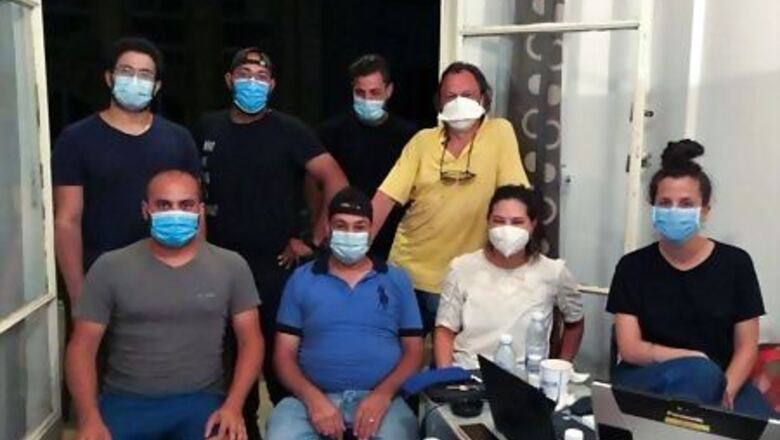
views
Imagine what it’s like to be flung to the floor by a gigantic explosion, dodge a falling wardrobe in your home, be cut in the forehead by flying glass – and then brush off the blood and start filming the news.
Reuters senior television producer Ayat Basma provided the world with some of the first images of the damage caused when 2,750 tonnes of ammonium nitrate, stored at the Beirut port, ignited and caused a blast that would end up killing at least 150 people and destroying a swathe of the city.
“I was lying on the ground, and all I could hear was the sirens of the car alarms,” said Basma, who had taken a day off work on Tuesday. “I thought, I don’t want to die.”
“Then the adrenaline kicked in.”
Bleeding from a gash in her head, with wet hair and hastily dressed, Basma rushed into the street and began filming with the only camera she had at hand – her smartphone.
Around her, bleeding and stunned residents clambered over glass and debris. Some people carried injured relatives and begged drivers in nearby cars to take them to the hospital.
In the building adjoining hers, the roof had blown off. Those who had looked up described a fireball in the distance that turned the sky into an orange and white mushroom cloud.
“Everything was down, the neighbours were shouting, the kids were crying,” said Basma. “All you could hear was the sound of cars driving on smashed glass.”
But I just kept saying to myself, “Film and send. Film and send.”
As journalists, we typically document and observe through a lens or behind a notebook. But this week, our colleagues in the Reuters Beirut bureau, our regional headquarters, were catapulted into the news even as they rushed to cover it. Several spent hours on the streets, while their families at home were injured and in shock.
Television producer Yara Abi Nader was driving when the blast happened. She had rolled down her car window to get some evening air, which helped her avoid getting shattered glass in her face. A shard sliced into her forehead, but she too immediately shot video on her phone to send to colleagues.
“I was focused on just one thing: getting my footage out,” said Abi Nader. “It was a form of denial – I didn’t really want to look at my face.”
Photographer Mohamed Azakir thought it was an earthquake when he first felt the ground shaking. When he reached the port area, there were bodies everywhere. He saw a man pinned from the torso downwards under a car, covered in dirt and blood. Azakir thought the man was dead, but he opened his eyes and waved his arms when the photographer approached.
Azakir called over some rescuers and helped them move the car to free the man. See his photos here: https://reut.rs/2EZUrzL
RAZED TO THE GROUND
Even before Tuesday’s explosion, the once elegant and beautiful Beirut city centre had already been ravaged by months of protests, and a crippling economic downturn. The blast delivered the final blow, smashing store windows long barricaded and forlorn.
Reuters downtown offices were also destroyed. Senior correspondent Ellen Francis hid under her desk as chunks of the ceiling crashed to the ground and window glass rocketed into computers.
Francis took out her phone to tell colleagues to send a news alert, or a “snap” in Reuters lingo. “I tried sending the message ‘Big Explosion’ and ‘Please Snap,’ but the letters came out jumbled because I was shaking so hard.”
“Are you OK?” screamed Bureau Chief Tom Perry, who had also sought refuge under the desk. He too tried alerting editors, and calling his wife and son. “We need to get out of here.”
Outside the office, Perry and Francis noticed a woman running towards them with open arms and blood streaming down her face. It was Abi Nader trying to get to the office.
“There is no office,” Francis said, as Perry led them to his apartment, where they worked throughout the night amid debris and bashed in walls.
Reuters Middle East Editor Samia Nakhoul has covered the Lebanese civil war, the invasion of Iraq, in which she was severely wounded, and the Arab Spring. When the explosion struck, she was in the car with her two teenage children.
With instincts from years of war reporting kicking in, Nakhoul told her kids to duck down and then left the car and ran for cover. “As long as I live I will never forget the trauma and the terror in the eyes of my children and the fear that gripped me of seeing them harmed. This tragedy rekindled memories I spent my life trying to forget.”
Nakhoul and her children ran home. She switched on her laptop.
You can see Reuters coverage of the day of the blast: https://reut.rs/2DHzIQD
Graphic-Beirut reels after deadly explosion: https://tmsnrt.rs/2PACt9a
Wider Image-Capturing a Beirut rescue: https://reut.rs/2EZUrzL)
(Additional reporting by Yann Tessier and Rosalba O’Brien; Editing by Tiffany Wu)
Disclaimer: This post has been auto-published from an agency feed without any modifications to the text and has not been reviewed by an editor


















Comments
0 comment